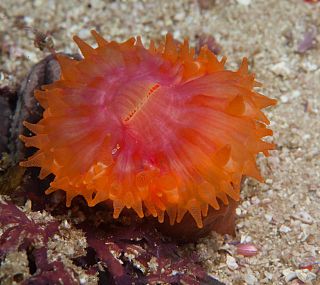
Potamididae, common name potamidids are a family of small to large brackish water snails that live on mud flats, mangroves and similar habitats. They are amphibious gastropod molluscs in the superfamily Cerithioidea.
The Chloroflexota are a phylum of bacteria containing isolates with a diversity of phenotypes, including members that are aerobic thermophiles, which use oxygen and grow well in high temperatures; anoxygenic phototrophs, which use light for photosynthesis ; and anaerobic halorespirers, which uses halogenated organics as electron acceptors.

Megasurcula is a genus of medium-sized predatory sea snails, marine gastropod molluscs in the family Pseudomelatomidae, a family previously lumped with others collectively known as turrids. Species within this genus occur in the Eastern Pacific Ocean
Leptadrillia is a genus of sea snails, marine gastropod mollusks in the family Drilliidae.

Caryophyllia is a genus of solitary corals in the family Caryophylliidae. Members of this genus are azooxanthellate and are found in the North Atlantic Ocean and the Mediterranean Sea at depths down to 2,670 metres (8,760 ft).

Tucetona is a genus of saltwater clams, marine bivalve molluscs in the family Glycymerididae, the bittersweet clams. Unlike other genera in the family, Tucetona species have a ribbed shell.

Dendrophyllia is a genus of stony cup corals in the family Dendrophylliidae. Members of this genus are found at depths down to about 900 metres (3,000 ft). They are azooxanthellate corals, meaning that they do not contain symbiotic photosynthetic dinoflagellates as do many species of coral.
The following is a taxonomy of extant (living) Brachiopoda by Emig, Bitner & Álvarez (2019). There are over 400 living species and over 120 living genera of brachiopods classified within 3 classes and 5 orders, listed below. Extinct groups are not listed.

Madracis is a genus of cnidarians belonging to the family Pocilloporidae. The genus has a cosmopolitan distribution.

Cancellothyrididae is a family of brachiopods belonging to the order Terebratulida. It was first described by James Allan Thomson in 1926.

Dallinidae is a family of brachiopods belonging to the order Terebratulida.
Laqueidae is a family of brachiopods belonging to the order Terebratulida.

Terebratulina is a genus of brachiopods belonging to the family Cancellothyrididae. The genus has a cosmopolitan distribution.
Pictothyris is a genus of brachiopods belonging to the family Frenulinidae.
Jolonica is a genus of brachiopods belonging to the family Frenulinidae.
Frieleia is a genus of brachiopods belonging to the family Frieleiidae.

Hemithiris is a genus of brachiopods belonging to the family Hemithirididae.
Campages is a genus of brachiopods belonging to the family Dallinidae.
Surugathyris is a monotypic genus of brachiopods belonging to the family Cancellothyrididae. The only species is Surugathyris suragaensis.
Terebratalia is a genus of brachiopods belonging to the family Terebrataliidae.









